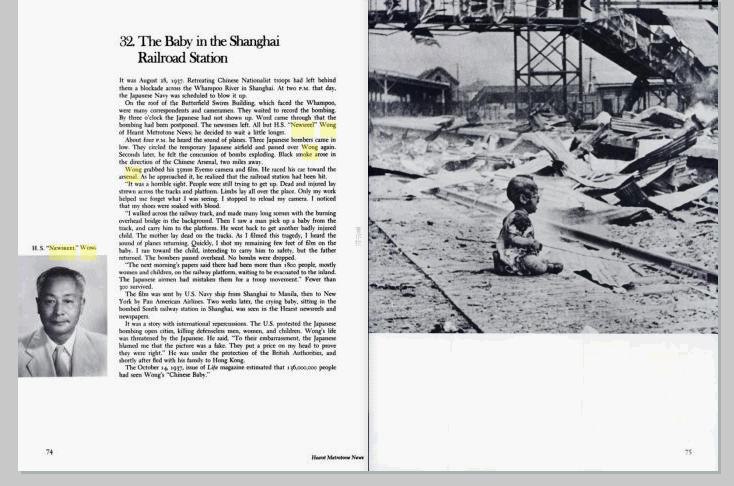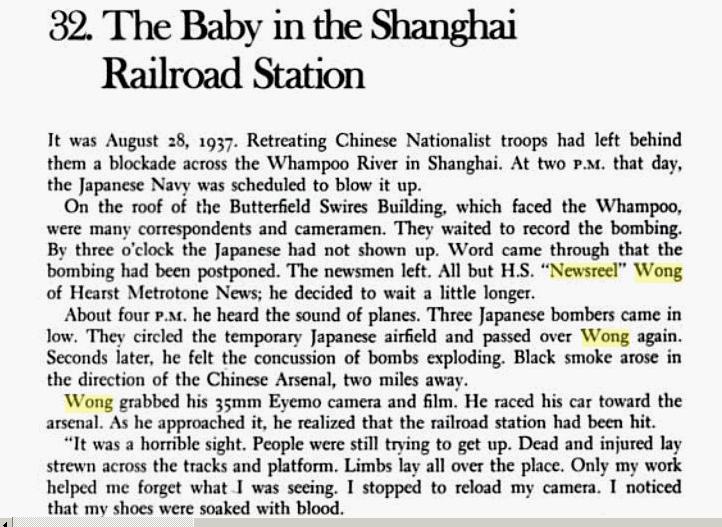15年戦争資料 @wiki
Great News Photos and the Stories Behind
最終更新:
pipopipo555jp
-
view
Great News Photos and the Stories Behind
From the Crimean War to Jimmy Carter, here are the shots professional photojournalists still discuss. 140 great photos and the stories of how they were taken. Lindbergh, death of Oswald, first men on the moon, others.
詳細
Great News Photos and the Stories Behind Them
著者: John Faber
出版社: Courier Dover Publications, 1978
ISBN 0486236676, 9780486236674
159 ページ
Great News Photos and the Stories Behind Them
著者: John Faber
出版社: Courier Dover Publications, 1978
ISBN 0486236676, 9780486236674
159 ページ
32ページ
32. The Baby in the Shanghai Railroad Station
上海鉄道駅の赤ん坊
上海鉄道駅の赤ん坊
It was August 28, 1937. Retreating Chinese Nationalist Troops had left behind them a blockade across the Whampoo River in Shanghai. At two P.M. that day, the Japanese Navy was scheduled to blow it up.
1937年8月28日、撤退中の中国国民党軍は、上海黄甫江を横切るバリケードを背後に残して去った。日本海軍はその日午後2時にはそれを爆破する予定を立てた。
On the roof of the Butterfield Swires Building, which faced the Whampoo, were many correspondents and cameramen. They waites to record the bombing. By three o'clock the Japanese had not shown up. Word came through that the bombing had been postponed. The newsmen left. All but H.S."Newsreel" Wong of Hearst Metrotone News; he decided to wait a little longer.
黄甫江に面したバタフィールド・スワイヤー・ビルディングの屋上には多くの新聞通信員やカメラマンが集まっていた。爆撃を記録しようと待機していたのである。しかし三時になっても日本軍機は現れなかった。爆撃は延期されたという言葉が流れてきた。新聞記者たちは去っていった。ハースト・メトロトーン・ニュース社の H.S."ニュスリールの"ウォンだけが、もう少し粘ってみようとそこに残っていた。
About four P.M. he heard the sound of planes. Three Japanese bombers came in low. They circled the temporary Japanese airfield and passed over Wong again. Seconds later, he felt the concussion of bomb exploding. Black smoke arose in the direction of Chinese Arsenal, two miles away.
午後4時、飛行機の轟音が聞こえてきた。3機の日本軍爆撃機が低空でやってきた。臨時の日本軍飛行場を周って戻ってきて、ウォンの頭上を再び通り過ぎていった。数秒後、爆弾破裂の衝撃を感じた。黒煙があがったのは、2マイル離れた中国軍兵器庫の方角だった。
Wong grabbed his 35mm Eyemo camera and film. He raced his car toward the arsenal. As he approached it, he realized that the railroad station had been hit.
ウォンは35ミリのアイモカメラとフィルムをひっ掴むと(引用者注:カメラとフィルムが入ったボックスのことか)、兵器庫に向って車を急行させた。近づくと、鉄道の駅が攻撃されたのだと分かった。
"It was a horrible sight. People were still trying to get up. Dead and injured lay strewn across the tracks and platform. Limbs lay all over the place. Only my work helped me forget what I was seeing. I stopped to reload my camera. I notices that my shoes were soaked with blood.
「それはそれは惨い光景でしたよ。人々は起き上がろうとして起き上がれず、死人やけが人が線路上やプラットホームに散らばっていました。もぎ取られた手足が、至るとことに転がっていました。そんな中で私の仕事が、見たものを忘れさせる(冷静になる)助けとなりました。
私は、カメラのネジを巻くために立ち止まりました。そして、靴にべっとり血が染み付いてることに気が付いたのです。」
"I walked across the railway track, and made many long scene with the burning overhead bridge in the background. Then I saw a man pick up a baby from the track, and carry him to the platform. He went back to get another badly injured child. The mother lay dead on the tracks. As I filmed this tragedy, I heard the sound of planes returning. Quickly, I shot my remaining few feet on the baby, I ran toward the child, intending to carry him to safety, but the father returned. The bombers passed overhead. No bombs were dropped.
「私は線路を横切るように歩いていき、燃える跨線橋を背景にしたロングショット(引用者注:遠景ショットのこと)をいくつも撮影しました。そして、一人の男が線路上から赤ん坊を拾い上げプラットホームに運ぶのを見ました。彼はまた、重傷を負ったもう一人の子供を助けにいきました、(二人の:引用者)母親は、死んで線路のうえに横たわっています。そうした惨状を撮影してたとき、飛行機が戻ってきた音が聞こえました。急いで私は、残り僅かのフィルムで赤ん坊を撮影しました。そして彼を安全な場所に移してやろうとしましたところ、父親が戻ってきました。(幸いにも:引用者)爆撃機は頭上を通り過ぎました。爆弾を落とされなかったのです。」
"The next morning's papers said there had been more than 1800 people, mostly women and children. on the railway platform, waiting to be evacuated to the inland. The Japanese airmen had mistaken them for a troop movement." Fewer than 300 survived.
「翌朝の新聞に依れば、殆どが婦人と子供からなる1800人が、プラットフォームで内陸への避難を待っていたとのことでした。日本軍の飛行士は彼らを部隊の移動と間違えたのです。」 生き残りは300人以下。
(引用者注)人数の記憶はどうか、当時の報道との対照で。
The film was sent by U.S. Navy ship from Shanghai to Manila, then to New York by Pan American Airlines. Two weeks later, the crying baby, sitting in the bombed South railway station in Shanghai, was seen in the Hearst newsreels and newspapers.
フィルムは米国海軍の艦艇で上海からマニラに送られ、パンアメリカン航空機でニューヨークに送られた。上海の鉄道駅爆撃の下で泣き叫ぶ赤ん坊は、2週間後には、ハーストのニュース映画や新聞を通して人々が見るものとなった。
It was a story with international repercussions. The U.S, protested the Japanese bombing open cities, killing defenseless men, wpmen, and children. Wong's life was threatened by the Japanese. He said, "To their embarrassment, the Japanese blamed me that the picture was a fake. They put a price on my head to prove they were right." He was under the protection of the British Authorities, and shortly after fled with his family to Hong Kong.
これは、世界的な反響を呼び起こす物語となった。合衆国は無防備都市への攻撃、無防備な男、女、子供の殺戮に抗議した。ウォン氏の生命は日本軍によって脅かされた。「日本軍は邪魔をする為に、映画はインチキだと私を非難しました。彼らのほうが正しいと主張するために、私の首に懸賞金をかけたのです。」とウォン氏は云う。ウォン氏はイギリス当局の保護下に入り、間もなく家族とともに香港へと逃亡した。
The October 14, 1937, issue of Life magazine estimated that 136,000,000 people had seen Wong's "Chinese Baby."
1937年10月14日号のライフマガジンは、ウォン氏の「中国の赤ん坊」を1億3千6百万人が見たと見積もった。
1937年10月14日号のライフマガジンは、ウォン氏の「中国の赤ん坊」を1億3千6百万人が見たと見積もった。




